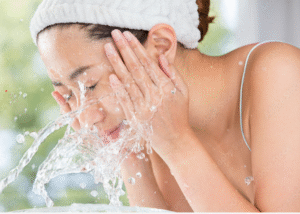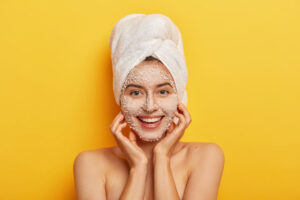Why Sunscreen is the Most Important Skincare Step
No matter your skin type, sunscreen is non-negotiable. Harmful UV rays cause tanning, pigmentation, early wrinkles, and even skin cancer. Using a good sunscreen protects your skin and also boosts the results of serums like Vitamin C and Retinol.
Benefits of Using Sunscreen Daily
- Protects from UVA (aging, pigmentation) & UVB (burning).
- Prevents premature aging, fine lines, and wrinkles.
- Keeps skin tone even, reduces dark spots.
- Locks in hydration when combined with moisturizers.
- Essential for post-treatment / active skincare (Vitamin C, Retinol).
Types of Sunscreens
- Mineral Sunscreens (Physical) – Use zinc oxide / titanium dioxide. Great for sensitive skin but may leave a white cast.
- Chemical Sunscreens – Lightweight, absorb UV rays. Good texture but may irritate sensitive skin.
- Hybrid Sunscreens – Mix of both, giving balanced protection + comfort.
How to Choose the Right Sunscreen
- Dry Skin → Cream/lotion sunscreens with hydrating ingredients.
- Oily Skin → Gel or matte finish sunscreens.
- Sensitive Skin → Mineral / hybrid sunscreens (fragrance-free).
- Daily Office Use → Lightweight fluid, invisible finish.
- Outdoor / Sports → Water-resistant, sweat-proof formulas.
- Apply sunscreen as the last step of your morning routine.
- Use at least ½ teaspoon for face + neck.
- Reapply every 2-3 hours if outdoors.
- Don’t skip sunscreen indoors – UVA passes through windows.
- Always remove sunscreen properly at night with cleanser.
What’s best in a sunscreen? UVA, UVB or both?
Check your sunscreen before you buy to ensure it is‘broad-spectrum’, which means it contains both UVA and UVB protection. Utraviolet A (UVA) has a longer wavelength, and is associated with premature skin aging, eye damage, while Ultraviolet B (UVB) has a shorter wavelength and is associated with skin burning and skin cancer4.
Remember that applying sunscreen doesn’t just help to reduce sunburn, it can also help to reduce the signs of aging. Aging UVA rays are present all day long and all year round – even in winter – and you can still be exposed to UVA radiation inside a car or close to a window.
Which SPF rating should I look for in a sunscreen?
Facial sunscreens tend to be at least SPF (sun protection factor) 50+, and for good reason. A high SPF sunblock can protect your skin from the damaging UV rays that cause premature aging and even help reverse the signs of damage by reducing dark spots, improving texture and boosting skin brightness3.
The SPF tells us how long we can expect to be exposed to UVB rays before burning compared to wearing no sunscreen. The higher the SPF, the greater the expected protection — for example, a SPF15 sunscreen provides about 94% UVB protection, but protection is increased to 97% with SPF30 and to 98% with SPF50+.



